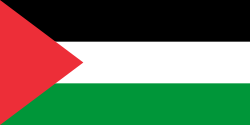History
South of Hebron (1875-1952)
In March 1875 Claude R. Conder, leader of the Palestine Exploration Fund survey team, reported the land south of Ain Jidy, close to Masada, belonged to the Jahalin. He met one of their sheikhs, Abu Dahuk, and noted the size and strength of their horses and their fondness for tobacco. He states that they had recently been driven from their country by Dhullam Arabs and mentions a war going on three hours from the team's camp at Bayt Jibrin. [1] Earlier in the same year one of Conder's colleagues on the survey listed the Jahalin as numbering 150 men, with 100 tents, after noting the "utmost civility" of all Arabs, settled or Bedouin, from the Ghor area (the Jordan River and Dead Sea rift valley). [2]
The Jahalin lived in the Tel Arad region of the Negev at the time of the creation of the state of Israel. [3]
Near Jericho under Jordanian rule (1952-1967)
In 1952, the Jahalin were evicted from their lands by the Israeli army and they settled at a location southwest of Jericho, within the Jordanian-ruled West Bank. [3] There, they took up their traditional seminomadic lifestyle, grazing livestock in the nearby area and the Jordan Valley.
Since 2014 eviction order
The tribe currently lives in villages such as ʿArab al-Jahalin, Wadi Abu Hindi, Al-Muntar, Al-Hathrura, Ghawaliya, Wadi Sneysel and Khan al-Ahmar east of Jerusalem, [5] bordered by the Israeli settlements of Maale Adumim and Pisgat Ze’ev. [6] On 16 September 2014 it was announced that they would be moved to a new area in the Jordan Valley north of Jericho. [7]
On 17 April 2012 a documentary about the Jahalin, "Nowhere left to go" directed by Harvey Stein, was premiered at the French Cultural Centre, Jerusalem. [8]
Since 2014, a football team made up of Jahalin Bedouin, the Desert Hawks, has been training and competing in the nearby Palestinian city of Bethlehem. [9]
This page is based on this
Wikipedia article Text is available under the
CC BY-SA 4.0 license; additional terms may apply.
Images, videos and audio are available under their respective licenses.

